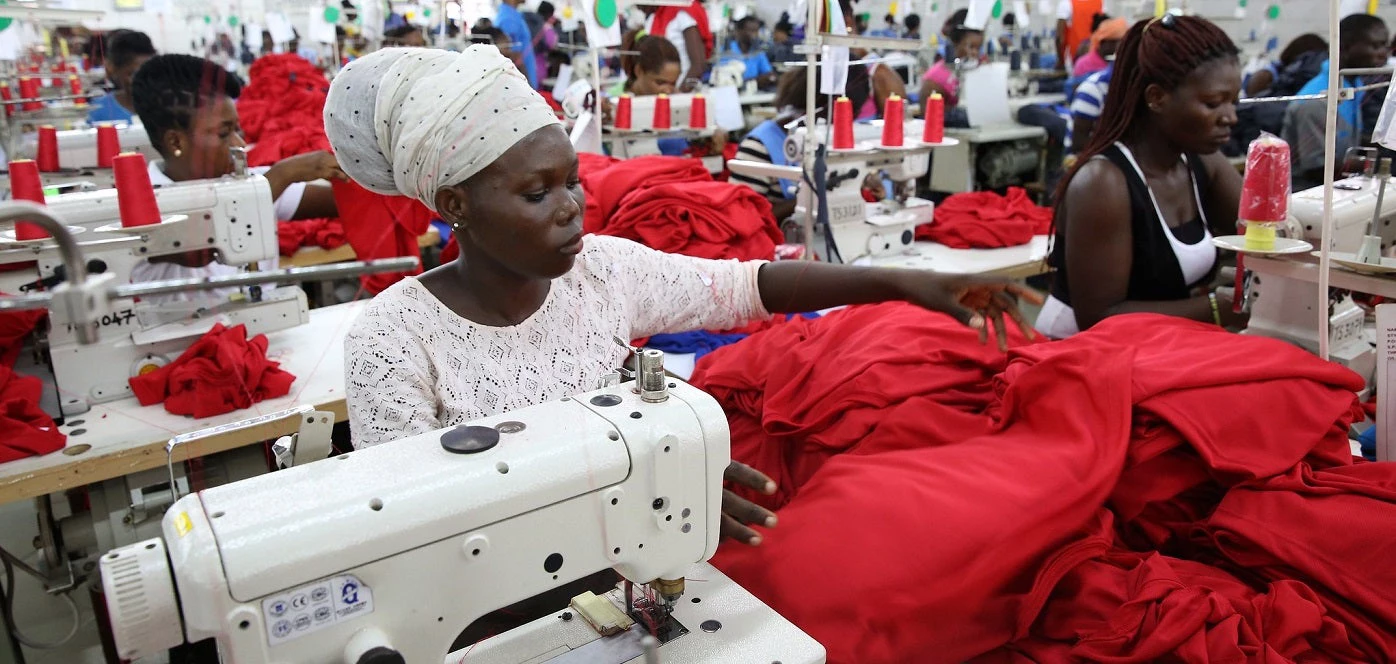 Dignity-DTRT, a garments factory in Accra, Ghana
Dignity-DTRT, a garments factory in Accra, Ghana
Disruptions to global value chains (GVCs) during the pandemic have reinforced calls for greater economic self-sufficiency and reshoring production of essential goods. New World Bank research, however, shows that reshoring would hurt both developed and developing countries and could contribute to a significant rise in poverty. Instead, the report suggests that countries, especially in the developing world, should move to fortify value chains and integrate into them more deeply.
Value chains—which split the production of goods and services into discrete activities that can be spread across the globe—have helped generate remarkable gains in prosperity. Between 1990 and 2017, low- and middle-income countries almost doubled their share in global exports, from 16 percent to 30 percent, as they joined value chains. During the same period, access to new markets and investment opportunities reduced the proportion of people living in extreme poverty from 36 percent to 9 percent.
But the COVID-19 pandemic showed that value chains can also be fragile. Border closures and lockdowns disrupted production and transportation, contributing to an 8 percent drop in trade in 2020—the biggest since the global financial crisis. Shortages of microprocessors made in Taiwan and South Korea were felt by makers of automobiles in the US and Europe. Retailers in high-income countries canceled orders for clothing, forcing factories in developing countries, including Bangladesh and Vietnam, to close and lay off thousands of workers. Some rich countries curbed exports of essential items such as food, medicines and surgical masks, leaving developing countries in the lurch.
Yet value chains ultimately proved resilient, the new World Bank research shows. Countries more deeply integrated into GVCs—especially in East Asia and China —rebounded more quickly from the crisis, and value chains helped spread the recovery across the globe. The report, “Reshaping GVCs in Light of COVID-19,” shows that lead firms chose to preserve costly investments in networks of suppliers and sometimes provided them with financial and technical support during the pandemic. In Cambodia, exporters overall were hit hard, but firms integrated into GVCs had higher survival rates than those involved solely in export.
While there is no sign yet that reshoring is happening on a large scale, the economic modelling in the report found that policies that are supportive of, not hostile to, trade could prove critical to strengthening the recovery from the pandemic and supporting greater diversification. Low- and middle-income countries stand to gain the most from strengthening trade GVCs, with a boost to real income growth of 10 percentage points by 2030.
A shift toward global reshoring to high income countries and China could drive an additional 52 million people into extreme poverty, most of them in Sub-Saharan Africa. Countries engaged in reshoring through tariffs and subsidies would also see their incomes decline as trade shrinks. On the other hand, measures to reduce trade barriers and ease the movement of goods and services across borders could support integration into GVCs, lift almost 22 million additional people out of poverty by 2030 , and improve the incomes of the bottom 40 percent.
Developing countries should therefore take steps to integrate more fully into GVCs and increase their resilience to shocks. Many small exporters face the risk that contracts will suddenly be cancelled. This is especially the case when companies are weakly integrated into trade networks and in countries where contract enforcement is weak. Governments can develop policies to mitigate these risks, including by improving access to trade finance.
Second, governments should invest in information collection and monitoring of markets for strategic goods. Doing so can reduce the likelihood of countries resorting to ad-hoc export restrictions. Combined with global agreements restricting the use of export curbs during a crisis, this will provide greater certainty of market access for developing countries.
Looking ahead, the report finds that the environmental and economic damage associated with climate change, along with government efforts to limit carbon emissions, could be major sources of stress. Existing GVCs are already feeling the effects. More frequent and intense extreme weather events, rising temperatures, and changing rainfall patterns are transforming traditional comparative advantages. These also increase uncertainty and, in the face of it, the need for resilience of trade in developing countries.
The global response to climate change has also raised additional challenges for low- and middle-income countries. High-income nations have promised to reduce their carbon emissions to meet their commitments under the Paris Agreement. The EU's Green Deal, for example, could result in a 75 percent decline in EU coal imports. This measure will affect fossil-fuel exporting countries and less developed economies integrated into carbon-intensive GVCs.
How should developing countries respond? They should diversify their exports away from fossil fuels and carbon-intensive manufactures. Instead, they should seek new opportunities and integrate into GVCs that support the use of more efficient and cleaner technologies, helping the transition to a greener future.




Join the Conversation